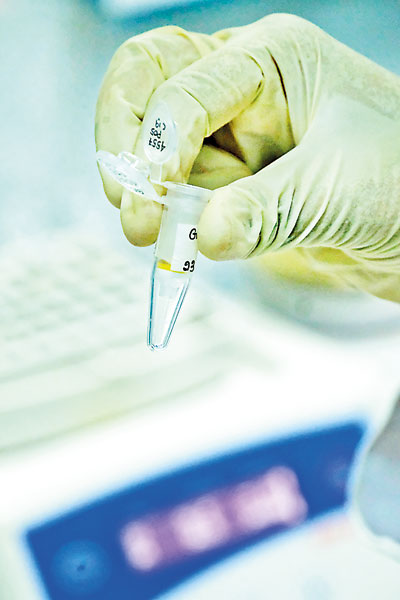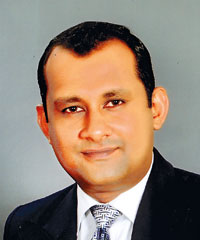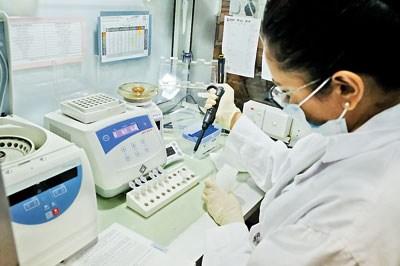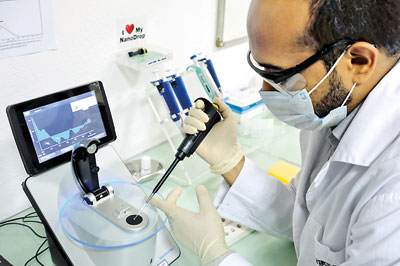News
A firm ‘yes’ or ‘no’ answer through DNA Profiling
With Sri Lanka reeling in the aftermath of the Easter Sunday bombings on April 21, the Government Analyst’s Department has without a doubt established the identity of the suicide-bombers within a month.

Human DNA extract in a tube Pix by Amila Gamage
How has the identity of the suicide-bombers been confirmed? The answer may seem simple but it is a complex process based on strong science. The unshakeable tool and expertise used is ‘DNA Profiling’.
What is DNA Profiling? It is in search of this answer that the Sunday Times turned to the pioneers in this field of study, Genetech, and spoke to its Senior Scientist and Head of Molecular Forensics, Dr Ruwan Illeperuma whose ‘DNA Field Guide’ on identification, isolation, handling and preservation of DNA is used extensively by the Sri Lanka Police.
Delving deep into DNA or deoxyribonucleic acid, Dr Illeperuma explains that all humans have very similar DNA. Around 99.7% of DNA in humans is similar, except a ‘fraction’ of DNA that makes someone ‘special and different’ from all others. This is the fraction which is tested for human identification.
He says that to test this fraction, the whole of the Nuclear and Mitochondrial DNA in a cell is not used, but only 0.1%, targeting the polymorphic region in the DNA or human genome which would help to establish the morphological (form, shape or structure) differences. The test entails measuring the sizes or lengths of the polymorphic regions.
“Therefore, DNA Profiling is simply a series of measures of 9-16 of such polymorphic regions. Each of these regions has been mapped and there is an internationally-accepted standardised name for it,” says Dr Illeperuma, explaining that the pairs of chromosomes that a human inherits from his/her biological mother and biological father will have distinctly different polymorphic regions.
He points out that as such, every human will have two distinct sizes or lengths for each polymorphic region, one passed down from the biological mother and the other from the biological father. Therefore, one DNA Profile can be used to establish the identity of a person and also trace all immediate biological relatives. Here it would be one profile but two applications.
Getting down to the nitty-gritty of DNA testing, he says there are two types:
Use of DNA to analyse biological material linked to a crime in a criminal investigation.
Use of DNA to establish maternity or paternity.
In both these instances, DNA is used to establish the identity of a person, it is learnt.
The question that needs to be answered in a criminal investigation is: Who is the source of a biological sample found at a crime scene?
This will be done by testing that biological sample, which could range from a hair shaft to a drop of blood, says Dr Illeperuma, categorising biological samples into two. They are:

Dr Ruwan Illeperuma
Solid biological samples detached from the human body such as hair; fragments of skin; flesh and muscles; bones; nails; and teeth etc.
Liquid biological samples such as blood, urine, saliva and semen.
According to him any physical evidence such as a cigarette filtre or butt, chewing gum, rubber slippers or clothes collected from a crime scene could contain one or more of 20 solid or liquid biological material of human origin.
“Analysing that fraction of DNA (polymorphic region) generates genetic information which helps create a ‘Genetic or DNA Profile’ which is unique to a human,” he says, stressing that in a crime scene investigation they seek a 100% match between the DNA Profile of the person and the biological samples found at the scene.
Citing the example of a cigarette filtre with saliva found at a crime scene, he says they will then take a blood sample from the suspect and carry out the Genetic Profiling to make sure that there is or isn’t a match.
However, when testing to establish family links, there would be 50% matching between two individuals, such as a child and a parent or two biologically-related individuals.
Comparing and contrasting the roles played by those carrying out forensic investigations – Judicial Medical Officers (JMOs) and DNA scientists – Dr. Illeperuma says that both groups examine biological material. While JMOs perform autopsies and collect samples, DNA scientists analyse biological samples.
“The JMOs give an ‘expert opinion’ to court but DNA scientists give a clear ‘Yes’ or ‘No’ answer, whether a biological sample found at a crime scene is from a suspect or not. These DNA scientists provide an evidence-based conclusion and not an opinion,” he explains.

Nail clippings of a victim being examined microscopically for fragments of skin from a suspect

DNA being extracted from a hair shaft
| What is DNA? Referring to DNA-based human identity testing, Dr. Ruwan Illeperuma holds up DNA or deoxyribonucleic acid to the light, making a complex subject seem like child’s play. DNA, he says, is a chemical found in almost all living organisms, whether microscopic or macroscopic, both animals and plants and is essential to sustain life. The ‘specific’ task of DNA is to encode (store) information and it is special because among thousands of chemical compositions, ‘storing information’ is what other chemical compositions cannot do. As such, the overall task of DNA is storing genetic information. According to this scientist the two types of information stored by DNA are: Information necessary to determine the physical look of an organism, called ‘phenotypical’ expressions or traits. These can be seen in the overall external look of a person – the colour of the skin, eyes and hair, whether hair is curly or straight, the height and the gender, to name a few. Information necessary to determine behavioural traits – the way a person walks, talks, feels, thinks and makes decisions. Within the physical body of an animal including humans or plants the ‘basic’ unit, meanwhile, is a cell and similar DNA is found in all the cells in an individual’s body, says Dr. Illeperuma explaining that the DNA would be in two places. They are: Nuclear DNA (nDNA) – every cell has a nucleus which controls it and there is DNA in the nucleus. Nuclear DNA is found in almost every cell in the body except red blood cells which have no nucleus. This Nuclear DNA is in a special structure called chromosomes and as such is also known as Chromosomal DNA. Each person inherits these chromosomes from his/her parents – 23 from the biological mother and 23 from the biological father, making it a total of 46 chromosomes. However, this is only specific (having 46 chromosomes) to somatic cells or any cell in a living organism except reproductive or sex cells (sperm and ova also known as gametes). Each sex cell has only 50% of chromosomes amounting to 23. When a sperm and ova (egg) fuse, a zygote (one cell) is formed. This zygote has 46 chromosomes and repeatedly divides to become a multi-cellular foetus. After the birth of the baby, each and every cell of that baby has Nuclear or Chromosomal DNA, inheriting 50% from the biological mother and 50% from the biological father. A conventional DNA test targets the chromosomes and as such is performed on Nuclear DNA. Mitochondrial DNA (mtDNA) – a small amount of DNA is outside the nucleus of the cell in the cytoplasm, the matrix within the cell excluding the nucleus. The cytoplasm has mitochondria which is the cell’s ‘powerhouse’ where respiration (release of energy) occurs. Mitochondria are small organelles floating free in the cell. Mitochondrial DNA, however, unlike Nuclear or Chromosomal DNA is exclusively from the biological mother (maternally inherited). If a biological sample has undergone extreme decomposition or degradation, almost all the Nuclear DNA may be unusable in a testing procedure. It is in these instances only that Mitochondrial DNA is used to give profiling information about the source of the sample.
| |
| Identical twins, the exception There is always an exception to the rule and this also applies to DNA Profiles being ‘unique’ to an individual. This fact of being unique does not apply to identical (monozygotic) twins. These are twins who develop from one zygote (fused sperm and egg cell) which splits into two. Other twins or fraternal (dizygotic) twins, however, develop from two separate eggs which have got fused with separate sperm to produce two individuals, each of whom would have his/her own unique DNA Profile.
|

Extracted DNA is quantified, prior to testing

